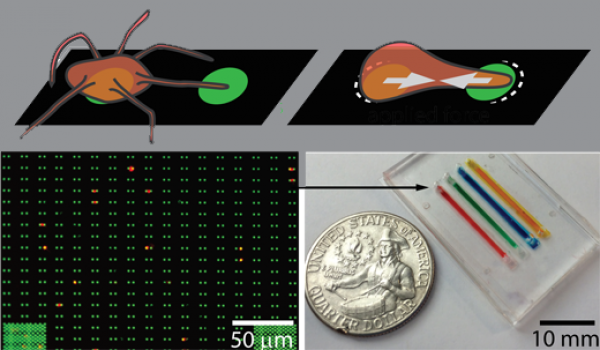Bleeding disorders could one day be diagnosed by putting platelets through strength tests, researchers have proposed.
Biomedical engineers from Georgia Tech and Emory have devised a microfluidic testing ground where platelets can demonstrate their strength by squeezing two protein dots together. Imagine rows and rows of strength testing machines from a carnival, but very tiny. Platelets are capable of exerting forces that are several times larger, in relation to their size, in comparison with muscle cells.
After a blood clot forms, it contracts, promoting wound closure and restoration of normal blood flow. This process can be deficient in a variety of blood clotting disorders. Previously, it was difficult to measure individual platelet’s contributions to contraction, because clots’ various components got in the way.
The prototype diagnostic tools are described in Nature Materials.
"We discovered that platelets from some patients with bleeding disorders are ‘wimpier’ than platelets from healthy people," says Wilbur Lam, M.D., Ph.D., assistant professor in the Department of Pediatrics at Emory University School of Medicine and in the Wallace H. Coulter Department of Biomedical Engineering at Georgia Tech and Emory University. "Our device may function as a new physics-based method to test for bleeding disorders, complementary to current methods."
The first author of the paper is instructor David Myers, Ph.D. Lam is also a physician in the Aflac Cancer and Blood Disorders Center, Children’s Healthcare of Atlanta. Collaborators at North Carolina State University led by Ashley Brown, Ph.D., contributed to testing the device.
The scientists infer how strong or wimpy someone’s platelets are by measuring how far the protein dots move, taking a picture of the rows of dots, and then analyzing the picture on a computer. The dots are made of fibrinogen, a sticky protein that is the precursor for fibrin, which forms a mesh of insoluble strands in a blood clot.
In addition to detecting problems with platelet contraction in patients with known inherited disorders such as Wiskott Aldrich syndrome, Myers, Lam and colleagues could also see differences in some patients who had bleeding symptoms, but who performed normally on standard diagnostic tests.
The researchers also used chemical tools to dissect the process of platelet contraction. They showed that inhibitors of Rho/ROCK enzymes shut down platelet contraction, but inhibitors of a related pathway, MLCK (myosin light chain kinase), did not. Individual platelet contraction could become an assay for development or refinement of blood thinning drugs, Lam says.
The research was supported by the National Heart Lung and Blood Institute (R01HL121264, U54HL112309) and a National Science Foundation CAREER award.
Emory Contact:
Quinn Eastman
404-727-7829
qeastma@emory.edu
Georgia Tech Contact:
Walter Rich
Communications Manager
Wallace H. Coulter Department of Biomedical Engineering
Georgia Institute of Technology
Media Contact
Georgia Tech Contact:
Walter Rich
Communications Manager
Wallace H. Coulter Department of Biomedical Engineering
Georgia Institute of Technology
Keywords
Latest BME News
Jo honored for his impact on science and mentorship
The department rises to the top in biomedical engineering programs for undergraduate education.
Commercialization program in Coulter BME announces project teams who will receive support to get their research to market.
Courses in the Wallace H. Coulter Department of Biomedical Engineering are being reformatted to incorporate AI and machine learning so students are prepared for a data-driven biotech sector.
Influenced by her mother's journey in engineering, Sriya Surapaneni hopes to inspire other young women in the field.
Coulter BME Professor Earns Tenure, Eyes Future of Innovation in Health and Medicine
The grant will fund the development of cutting-edge technology that could detect colorectal cancer through a simple breath test
The surgical support device landed Coulter BME its 4th consecutive win for the College of Engineering competition.









